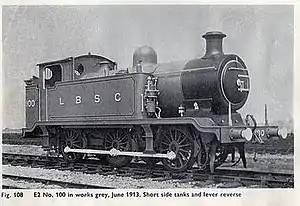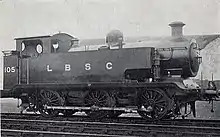| LB&SCR E2 class | |||||||||||||||||||||||||||
|---|---|---|---|---|---|---|---|---|---|---|---|---|---|---|---|---|---|---|---|---|---|---|---|---|---|---|---|
 First series E2 with short side tanks, 1913 | |||||||||||||||||||||||||||
| |||||||||||||||||||||||||||
| |||||||||||||||||||||||||||
| |||||||||||||||||||||||||||
| |||||||||||||||||||||||||||
The London, Brighton and South Coast Railway (LB&SCR) E2 class was a class of 0-6-0T steam locomotives designed by Lawson Billinton, intended for shunting and short distance freight trains. Ten examples were built between 1913 and 1916, and were withdrawn from service and scrapped between 1961 and 1963.
Background
By 1910, many of the Stroudley E1 class locomotives were worn out or inadequate for the heavier duties required of them. D. E. Marsh intended to rebuild some examples with a larger boiler, but only one E1X rebuild had been completed by the time of his unexpected retirement. Marsh's successor Billinton reversed this policy and instead ordered five new, more powerful locomotives from Brighton railway works.[1] The new class included several features found on other LB&SCR classes including an I2 class boiler. They were delivered between June 1913 and January 1914.

Second Series
The new design was judged to be successful, except that they were found to have inadequate water supply. Thus when a further order for five locomotives was placed they were given extended side tanks. The second batch were delayed by the onset of World War I, but were eventually delivered between June 1915 and October 1916.
Use
The E2 class locomotives were mainly used for the heavier shunting and short distance freight duties in the London area and on the south coast, as their small coal bunkers made them unsuitable for long trips. These included empty stock workings at Victoria and London Bridge Stations.
Two were tried on passenger services with Push-pull trains in 1914, with the locomotives in the middle of a rake of six coaches, but the experiment was abandoned during the same year as they had insufficient coal capacity.[2]
Following the electrification of the Brighton line in 1936, the class was used as replacements for the former LCDR T class at the Herne Hill marshalling yard, around Victoria station and at Dover harbour. During World War II, they also replaced the SR Z class at Hither Green marshalling yard.
The class were trialled as dock shunters at Southampton in the 1950s, and were found to be suitable for the task. Six examples were retained for this purpose until their replacement by British Rail Class 07 diesel shunters in 1962.[3]
Withdrawal of the class took place between February 1961 and April 1963, and were all scrapped.
Locomotive summary
| LB&SCR No. | Date Built | S.R. No. | B.R. No. | Date Withdrawn |
|---|---|---|---|---|
| 100 | June 1913 | 2100 | 32100 | November 1961 |
| 101 | August 1913 | 2101 | 32101 | September 1962 |
| 102 | October 1913 | 2102 | 32102 | October 1961 |
| 103 | December 1913 | 2103 | 32103 | October 1962 |
| 104 | January 1914 | 2104 | 32104 | April 1963 |
| 105 | June 1915 | 2105 | 32105 | September 1962 |
| 106 | September 1915 | 2106 | 32106 | October 1962 |
| 107 | March 1916 | 2107 | 32107 | February 1961 |
| 108 | July 1916 | 2108 | 32108 | June 1962 |
| 109 | October 1916 | 2109 | 32109 | April 1963 |
Thomas the Tank Engine
In 1946, Reginald Payne used the later series of E2 locomotives as the basis for the character Thomas the Tank Engine in the second book of The Railway Series by the Reverend W. Awdry.[4][5]
00 Gauge models
Trix produced a model of the first series Class E2 in 1961. It was designed for the Trix Twin 3-rail system but could be converted to 2-rail using the optional 2-rail pick up included with the locomotive.
Hornby produced the locomotive in its earliest form as an 00 gauge model. Production lasted from 1979 to 1985 in three distinct variants with four reference numbers.[6] In 1985 the tooling was retired and after some alterations, was instead used as the basis for the Thomas the Tank Engine model.
Bachmann have also produced several different-coloured E2-based models in their Junior Range.
References
- ↑ Bradley, (1974) p.128
- ↑ "SREmG".
- ↑ Bradley, (1974) pp.129–131
- ↑ Sibley 1995, p. 123
- ↑ "Thomas the Tank Engine". (The real prototype locomotives that inspired the Rev W Awdry). The Real Lives of Thomas the Tank Engine. Archived from the original on 13 December 2004. Retrieved 4 April 2011.
- ↑ "Hornby Railways Collector Guide - Class - Class E2 - Steam".
- Bradley, D.L. (September 1974). Locomotives of the London Brighton and South Coast Railway: Part 3. London: Railway Correspondence and Travel Society.
- Sibley, Brian (1995). The Thomas the Tank Engine Man. London: Heinemann. ISBN 0-434-96909-5.